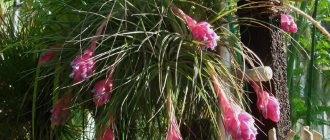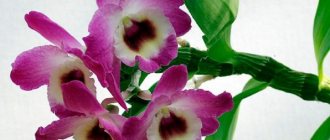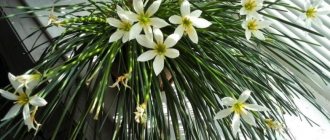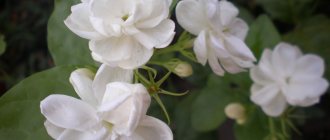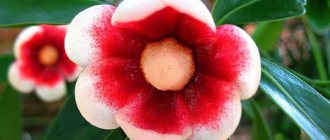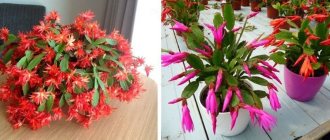Solyanum - home care
Solyanum is native to the island of Madeira and Brazil.
There are two varieties of the plant - Solyanum capsicum and false pepper. The false pepper subspecies is much more common; its main difference from the pepper subspecies is the hairless young shoots. The fruits are round, red or yellow, with a diameter of 2.5 centimeters. Fruiting solanums go on sale between May and June. Interestingly, the fruits last until winter. After fruiting, the plant is usually discarded, despite the fact that it is a perennial. If we arrange a normal winter in a cold room, the solyanum can please us for many years. In this case, they need strong spring pruning.
Solyanum or nightshade has an interesting “relative”. Its fruits are white in color and resemble chicken eggs, hence the name “egg tree”. The official name is indoor eggplant.
The representative of the flora reaches approximately 50 centimeters in height in a pot and prefers a not cold, but ventilated room. Its fruits can be eaten. The climbing species can only be recommended for large winter gardens; they all develop beautiful blue or white flowers. A well-known tub shrub is Solyanum Rantonetti, it is also known as Lycianthes, the maximum height is 2 m.
What should be the correct one? Let's try to figure it out.
Features of caring for solyanum
The plant is suited to a sunny place, protected from direct rays. Nightshade jasmine grows well even in partial shade.
Temperature conditions for solarium
It is necessary to find a well-ventilated place; in summer, a terrace or a warm balcony is considered ideal. Under such conditions, the solyanum produces much more fruit than indoors. The optimal temperature in winter is 10-15 degrees, the lower threshold is 5 degrees Celsius, for the Wendland and Siefort varieties it is 18.
Air humidity for solyanum
Maintain moderate humidity all season. In summer, it is necessary to provide more water; in winter, watering is reduced somewhat, but overdrying is not permissible. Overdrying the earthen clod in summer will lead to the flowers falling off.
Fertilizer for solyanum
Proper care of solyanum at home involves regular application of fertilizers. Feeding is done once a week from the beginning of spring to the end of autumn. In winter, it is recommended to give flower fertilizer once a month.
Methods for propagating Solyanum
Solyanum is propagated by seeds. It is recommended to start sowing in March. Shoots will appear only if the soil temperature is maintained at 18 degrees. Pinch the seedlings once or twice to improve branching. Large shrubs and climbing species are propagated by cuttings. Cuttings take root at high air humidity and soil temperatures of 20 degrees.
Protection of Solyanum
Some nightshade species are often affected by greenhouse aphids. Experts advise providing a not too warm, ventilated room as a preventive measure. In addition, regular monitoring is needed. If we talk about winter gardens, then biological control measures are used here.
As you can see, caring for solyanum at home has its own characteristics and rules, without knowledge of which it will be difficult to obtain a healthy and beautiful plant.
Types of Solyanum
The Solyanum genus is very numerous, with more than 1000 species recorded. The most decorative varieties are grown as indoor plants.
The plant in the form of a tall (up to 120 cm), spreading bush retains its crown all year round. The bare, bright green stems are heavily branched. Long (up to 10 cm), lanceolate leaves with a wavy edge are attached to the stem on a short petiole. Single flowers on a thin peduncle bloom from the axils of the leaves. The diameter of the white stars is 1 cm. By mid-summer, the bush is decorated with round orange berries with a diameter of 1.5 cm.
The species is more compact in size. Young shoots are covered with short pubescence, while older shoots are covered with dark brown, rough bark. The length of the dark green leaves does not exceed 8 cm. There is a variety called Solyanum capsicum variegatum with white stripes on the foliage.
The plant is a long (up to 5 m), creeping vines. There are small hooks on the petioles and stems that help the plant climb the support. The length of the leaves can reach 22 cm. On one plant there are both single lanceolate and pinnately dissected foliage. The paniculate inflorescence consists of white star-shaped flowers with a diameter of about 5 cm. Later, orange round berries ripen on the stems, their size is 1.5-5 cm.
– annual subshrub up to 1.2 m high. Oval or ovate leaves have a pointed edge and wavy, less often jagged sides. White-green small flowers are collected in umbrella inflorescences. Later, clusters of black berries with a diameter of 8 mm are formed on the branches. Solyanum nigrum is used in homeopathy.
It is a perennial creeping shrub up to 4 m high. Long pubescent stems gradually become woody and bare. Oval leaves are located on most of the stems. They are painted bright green and have a shiny surface. The tips of the leaves are pointed and the edges are covered with rounded teeth. Drooping buds are collected in a few-flowered umbrella. The petals are colored light purple or blue. Red oval or round berries reach 3 cm in diameter.
– an evergreen semi-lignified shrub up to 1.5 m high. The plant is covered with oval, slightly pubescent foliage of a light green hue. During the flowering period it is covered with small white and purple flowers. The pear-shaped fruits are yellow with purple streaks. The length of one fruit reaches 20 cm, and weight – 400 g.
Diseases and pests of solanum
With poor care and improper watering, the flower may suffer from root rot.
Externally, the plant looks as if it is drying out, but if the substrate is wet, then it is worth removing it from the pot and inspecting the roots. In solanums affected by root rot, they are soft, unnatural in color and emit an unpleasant odor. Such a plant cannot be saved; it should be destroyed and the pot thoroughly disinfected.
Another unpleasant problem is an attack by whiteflies, aphids or spider mites.
In the summer, these pests can fly in with the flow of fresh air, especially in dry and hot weather. To the delight of gardeners, they are easy to get rid of with the help of modern chemicals.
Good care, care and attention will help you cope with all difficulties and grow strong, regularly fruiting solanum
Benefits and harms
Unripe solanum berries are poisonous and cause severe stomach upset, so you should be careful when growing it in a home where there are small children and pets. If you cannot deny yourself the pleasure of keeping this beauty in the house, place the flower out of the child’s reach. It is not recommended to keep solanum in the bedroom, especially in the nursery.
However, ripened fruits and green young stems can be beneficial. The cut, dried tops of the plant are infused with alcohol and used for colds, asthma and eczema. As an external medicine, it is used to treat wounds and ulcers. As part of sedative mixtures, it helps cope with depression. However, everything is good in moderation; abuse of such drugs can be fraught with poisoning.
Solyanum propagation
Solanum can be diluted in 2 ways:
- cutting method;
- seminal.
Propagation using stem cuttings
For this propagation method, you can leave cut branches that were pruned in the spring. Choose the strongest ones from them, and try to root them in a substrate of peat and sand. After some time, the cuttings will begin to take root, after which they are transplanted into separate vessels. The containers must first be filled with humus (2 parts), turf soil (1) and sand (1). It is worth remembering about the drainage, which is laid out at the bottom of the pot. In order for there to be good branching, after picking, the young flower must be pinched. For the same purpose, you can prune the plant several times throughout the warm season.
Seed propagation method
This breeding method is also quite popular. To do this, you need to take leaf soil, sift it, pour it into a container, and spread the seeds on the surface of the soil. The next step is to sprinkle the seeds with a thin layer of sand and water a little. Then place the tank in a warm place (about 22 °C) and cover it with glass or polyethylene. After 20 days, sprouts should form, which will need to be replanted twice as they grow. Afterwards, young specimens are planted in the ground, the substrate is used the same as in cutting propagation and care is carried out in the same way.
Caring for solyanum at home is not very difficult. If you follow the above recommendations, the flower will delight you with its unique blooming.
Features of home care
Solanum is a unique plant, it is beautiful at any time of the year: flowering gives way to the formation of bright green ovaries, gradually acquiring a red tint. The bush is covered with multi-colored balls, which are replaced by buds again. To admire this beauty all year round, you must adhere to certain flower care rules:
Have you seen an unusually beautiful ornamental plant with bright, intricate fruits that look like berries? This is a solanum bush
.
It has many popular nicknames: potted cherry, nightshade or coral tree. An exotic plant will decorate any home if it is cared for according to all the rules.
Is indoor nightshade dangerous?
All parts of nightshade are poisonous. It is especially dangerous to eat its fruits. They taste bitter, so no one will eat them just like that. This plant is dangerous only for small children. It is difficult to resist the temptation to taste the bright orange berry. The child will not eat many of these fruits - they taste unpleasant. But you can get indigestion! In addition, there are cases where babies swallowed berries whole or they got into the respiratory tract.
Decorative nightshade is considered a dangerous indoor plant; it is not recommended to have it at home if you have small children. Wait until they grow up!
Superstitions
According to the teachings of Feng Shui, for harmony in the house there should be a plant in the shape of a ball. Solanum with the correct crown balances the energy in the house. According to superstitions, Solanum pseudocapsicum and other species are the object of attraction of positive energy. Although not all people believe in superstitions, nightshade will look very original in the house and will add freshness and brightness to the interior.
Each plant is original and beautiful in its own way. One has a delicate, unique aroma, the other has an unusual appearance and bright flowers, the third has an unusually beautiful leaf color. Solanum belongs to a group of unique indoor plants and is becoming increasingly popular among gardeners. He feels great at home without requiring special care.
General information about the Solanum plant
Appearance
The bright orange fruits of Solanum look a bit like cherries. The flower itself is able to maintain its decorative effect throughout the whole season.
Nightshade is considered a fairly popular, but also a demanding plant to care for; in order to maintain the beauty of Solanum, a sufficient amount of effort must be made.
Properties
I
Young fruits of Solanum are considered poisonous, and if they enter the stomach of an animal or a person, they can cause poisoning. It is also forbidden to keep Solanum in a child's room.
Caring for a plant at home
Lighting. Solanum is a very light-loving plant. If there is not enough light, this will lead to the fact that there will be few leaves on the stems, and the flower itself will not bear fruit. If possible, place the flower pot on the window on the west or east side. Nightshade should be shaded only on hot summer days to protect its leaves from “burning”. The rest of the time, sunlight will only benefit the plant.
Temperature. If the air temperature in the room where the solanum flower is located is more than 20 ° C, there is a high probability that the leaves on it will turn yellow, and the fruits will quickly “shrink” and fall off the stems. The optimal temperature for flower growth is up to 18 °C.
Fertilizer. In the summer, experienced gardeners fertilize the tree with special liquid fertilizers intended for ordinary indoor plants. Doing this once a week is enough. And when the plant blooms, it would be a good idea to treat it with an insecticide.
Watering. During the active growth of a flower, the soil where it is planted must be constantly moist. If we talk about the winter period, the plant does not require frequent watering.
Air humidity. In order for nightshade to grow well, it must be regularly sprayed with water. If the air in the room is very dry, the plant may be affected by aphids or red spider mites. To avoid the hassle of constant spraying, place the pot with the solanum flower on a tray where you add wet pebbles, for example. This way you can provide the nightshade with an optimal moist environment.
Transfer. As a rule, solanum is transplanted in February. It is during this period that the plant withers and sheds its fruits and leaves. How to do it? The optimal proportions are as follows: clay soil - 2 parts, humus soil - 2 parts, leaf soil - 1 part, sand - 1 part. When replanting the plant, ensure it has good drainage.
Circumcision. To ensure that the tree has a beautiful shape, learn how to prune it correctly. First, the main stem is shortened by half. But when the active growth of side shoots begins, they should be pinched.
Reproduction. The solanum flower can be propagated both by cuttings (in March) and by seeds. Seeds, as a rule, fall into the ground themselves and begin to germinate. In this case, the young flower needs to be dug up and transplanted to another place. If you decide to grow a tree from a cutting, it is better to start planting in the spring. To create ideal conditions, the cuttings are planted in sand moistened with water, and when they begin to take root, they are transplanted into the ground. When the flower reaches 15 cm in length, it can be pinched.
Description and photo of Solanum - first acquaintance
A description of the culture may take several pages, but we will not bore you with boring and dry facts from the botanical library. Still, this is the first acquaintance with an unusual shrub. The solanum flower is a prominent representative of the nightshade family, which is poisonous. It has no special requirements for the environment, but a lack of sunlight can lead to excessive elongation of branches and loss of attractive appearance. Look at the photo of solanum - the period of fruit ripening makes it a real beauty:
In the first year of development, the shrub requires a careful approach to the formation of a beautiful crown. Elongating shoots should be trimmed in a timely manner. After 1.5 - 2 years, snow-white buds bloom in the axils of the leaves, inside of which there is an ovary. All varieties, without exception, are self-fertile crops, which allows you to successfully set berries indoors without external pollination. Experienced gardeners recommend vigorously shaking the plants once a day during mass flowering. This improves the percentage of fruit set. Can solanum fruits be eaten or used in any way? No, this is strictly prohibited. The berries contain the strongest poison - solanine. Keep children and pets safe. They should not have access to bushes.
Botanical description of false pepper nightshade
False pepper nightshade (lat. Solanum pseudocapsicum) is grown as an ornamental plant. It is a subshrub 30 cm-1.8 m high; when grown indoors, it is limited to a height of 60 cm. The long, twisting stems of the plant are densely covered with leaves. The leaf blades are ovoid in shape with pointed tips, dark green in color.
The flowers are like potatoes: regular in shape with a double perianth, five stamens and one pistil, narrow anthers, fused around the style into a cone-shaped tube. Most often the flowers are white, but may have a bluish tint. The fruits are ellipsoidal berries about 1 cm long, they are shiny, the green color changes to yellow, orange, and red as they ripen.
Solanum is incredibly hardy; even an inexperienced gardener can handle growing and caring for it. Create favorable conditions, water, periodically feed the plant and prune.
A decorative tomato will decorate a home, apartment, office, or any institution with dark green leaves and a scattering of bright berries. An unusual and bright bush fills the space with light, charges with positivity, and its fertility and unpretentiousness add advantages to it.
In its natural environment, false pepper nightshade is common in South America; it can be found in all corners of the globe with warm climates. Prefers places along the banks of water bodies, in damp meadows, and in thickets of bushes.
When does solanum bloom and bear fruit?
Solanuma begins in spring or summer (May-August). Then the fruits are set; if there are few of them, pollination has not occurred (next time the plant needs to be helped by cross-pollination).
Solanum pseudocapsicum: can the fruits be eaten?
The external attractiveness of the fruits of false pepper solanum is deceptive. The berries are saturated with the toxic substance glycoalkaloid solanine. Eating solanum fruits leads to stomach upset. This is especially dangerous for children and pets, so their access to the plant should be limited. It should be noted that among the representatives of the genus there are plants with edible fruits - black nightshade, sunberry, pepino, naranjinya or Quito nightshade, cocona.
Solanum orange: are the leaves poisonous or not?
Other parts of false pepper solanum are also poisonous, so avoid getting the juice on the mucous membranes and skin. Wear gloves when working with the plant, and wash your hands thoroughly afterwards.
Beneficial properties of solanum pseudocaspicum
Ripe berries of nightshade are used in folk medicine to treat sore throat. Leaves and stems have an insecticidal effect. Their decoction (take 5-6 kg of fresh raw materials per 10 liters of water) is sprayed on plants against aphids and other pests.
Is it possible to eat the fruits of Solyanum?
You cannot eat the fruits, they cause poisoning to the body. It is possible that the effect of a dangerous poison on the body will contribute to the death of humans or domestic animals.
Berries of the Solanum plant - photo
Plant poisoning remains a common phenomenon. False information leads to these negative events. But a lethal dose can be obtained if the berries are eaten in large quantities.
The plant contains a complex substance - solanine. Contains the following molecules:
- Solanoidine alkaloid is the main substance that activates the process.
- Glucose molecules.
What is solanine? It is a glycoalkaloid and is of plant origin. His name is given from Nightshade. The plant component performs several important functions in nature.
It protects plants well from pests. This substance was developed by nature and serves to protect humans.
Plants with poison entered world cultures quite a long time ago. Potatoes are considered the most popular.
Products that contain substances that are harmless to humans are placed on the table. Solyanum berries are used in traditional medicine recipes, but only for external use.
Plant care
Nightshade is quite hardy and unpretentious; caring for it does not take much time or effort. It is enough just to create the right conditions for its growth and development, and do not forget about watering and fertilizing.
Lighting
Solanum is extremely photophilous, but prefers diffused light
, and direct sunlight can be harmful to it. It is preferable to place nightshade near windows located on the east and west sides. If you plant solanum on the south side, then in the daytime (12:00 -17:00) you need to remember to slightly shade the window. It is better not to plant it on the north side.
If possible, in summer you should take the solanum outdoors, remembering to protect it from excessive sun, wind and rain. Such a temporary “move” will strengthen the plant and make it more fruitful.
Temperature
Solanum bears fruit best at temperatures just above +18°C. Therefore, the optimal summer temperature in the room where the plant is located is +18...+25°C, and the winter temperature is +15...+18°C. If the bush is left at a higher temperature during the cold season, this can lead to yellowing of the leaves and dropping of the fruit.
The soil
To grow solanum, a highly breathable substrate is used. It should be moisture-retaining soil with good aeration and a neutral pH in the range from 5.5 to 7.5. For young shoots, a soil consisting of one part sand, two parts peat or humus and one part turf soil is well suited.
Watering
In the warm season (from April to September), daily abundant watering
solanum. But at the same time, the top layer of soil in the pot should dry out a little between two waterings. During the rest of the year, nightshade needs less watering; gradually it can be limited to once a week.
It is advisable that during the cold season the bush should be in a cool and bright room with high humidity. With the appearance of new branches (around February), the amount of watering should be increased.
Important! Please note that solanum needs fresh air, but it is afraid of drafts
Therefore, ventilation of the room, especially in the cold season, should be done with extreme caution.
Humidity
The fruiting of solanum largely depends on the humidity in the room. The recommended humidity should be 65%, and the leaves should be sprayed daily. To create the required level of humidity, you can place a pot of solanum in a tray of water filled with expanded clay, peat and wet pebbles, but the bottom of the pot should not touch the water.
Top dressing
Like almost any plant, nightshade needs additional feeding. If you don’t add it, it will grow slower and bear fruit much worse. Therefore, in the warm season, starting in May, liquid fertilizers are added to the pot with solanum once every one or two weeks.
. Products for tomatoes and flowering plants, such as Ideal or Rainbow, are well suited for this purpose.
Trimming
In the first year of growth, the nightshade crown is formed. To do this, the shoots should be pulled out in time, which they begin to do about 3-6 months after planting. Primary pruning consists of pinching out all overgrown branches at the level of the second bud. The plant is pruned for the second time when the side branches reach 10 cm. At the same time, they are shortened to a level at which there are two buds.
After all the berries have ripened, when the nightshade leaves begin to turn yellow, renewal pruning is carried out to about a third of the height of the plant. And in the spring the bush is pruned so that the required shape is obtained.
Transfer
After pruning, the solanum is transplanted into a pot with a mixture of one part sand, two parts or humus and two parts of turf soil. Be sure to place drainage at the bottom of the pot so that the nightshade root system does not rot.
About the rules for self-care of Solyanum
After purchasing a plant, it is important to replant it correctly. To do this, you need to choose a flower pot that is quite spacious, since the root system develops quickly.
Several stages of planting:
- The dimensions of the container are selected proportionally relative to the crown.
- The plant can also be planted by seeds. The land must be initially cultivated so that the bush does not develop various diseases. The soil is pre-moistened with water, then seeds are placed there and sprinkled with a little earth.
- Film or glass is placed on the container to create a greenhouse effect. This way the seeds will hatch quickly.
- In about two weeks the first shoots will appear.
The plant is easy to care for; the flower is unpretentious and hardy. To do this, you need to ensure timely watering, fertilizing and the right conditions for growth.
A few rules for care:
- At the beginning of spring or at the end of spring, the seeds of the plant begin to be sown. Use soil consisting of leaf soil, peat and sand. Be sure to make drainage from expanded clay. You need to pour sand on the seeds and cover them with polyethylene. This will create a greenhouse effect.
- It is worth moistening and aerating the soil daily. Sprouts will be visible in two weeks. Upon reaching 10 cm in length, pinching is necessary.
- Since the plant is tropical, it needs to create certain conditions for growth.
- The illumination must be ensured appropriately: prevent the sun's rays from entering and at the same time determine the illuminated place.
- It is necessary to water abundantly in summer. If the top layer is dry, it needs to be moistened. High air temperature is undesirable for the plant; it can be moistened by spraying.
- The crop is fed with liquid fertilizer twice a week during the growth period.
Types of Solanum
This is an indoor perennial plant belonging to the nightshade family. It is an evergreen deciduous shrub slightly more than half a meter high. The homeland of nightshade is the South American shores. The exotic look of the shrub is given by its elongated glossy leaves and branches constantly showered with berries and flowers. Bright orange and red fruits
They resemble cherries, hence the popular name.
Bright and attractive berries, beckoning from afar, are the plant’s natural protection. They are poisonous, so it’s not worth trying them on the tooth even for the sake of curiosity.
And this fact must be taken into account if there are small children or pets among the household.
There are more than 1,500 species of nightshade in nature. In our area, only a few can be found at home.
Nightshade pepper
The view is more compact in size. It is distinguished by smaller fruits and delicate shoots. This shrub is from southern Brazilian and Uruguayan forests. Popularly known as the “angina tree”
, since a healing infusion is made from its shoots.
False pepper nightshade
A shrub up to 1.2 meters high with oval leaves and small white flowers. It bears fruit with round red or yellow berries. At home, a low-growing form of nightshade takes root. This species originates from the island of Madeira.
Both varieties of solanum are adapted to home conditions, but for some of them they are very demanding.
Characteristics and description of Solyanum
What is Solyanum (Solanum or nightshade)? An indoor flower with orange berries is called Solanum. This is an evergreen shrub, looks miniature and resembles a spreading bush. The root is branched and located on top of the soil.
The height of the plant reaches 1.2 meters. The branches stand straight, forming a crown that is impossible to penetrate. They quickly begin to become woody and covered with bark.
Solanum flower in a pot - photo
Leaves appear on the shoots in the shape of an oval, one after another. The surface resembles gloss, and their edges are wavy. Veins protrude on dark green leaves.
The length reaches 10 cm and the width - 5 cm. The plant blooms in the warm season - in summer. On the shoots there are inflorescences in the form of umbrellas. Small bells form buds. A pleasant aroma emanates from them. Each bud has its own elongated peduncle. The flower reaches three centimeters in diameter.
Large berries appear where the flowers are located. Several small and white seeds can be found in the pulp. The skin of the berries is elastic, red, orange or yellow.
The berries remain on the bush for a long time, and thus the aesthetics are preserved. They can be 5 centimeters in diameter, but in most cases they are small. The flower is considered life-threatening, and the fruits should not be eaten as severe poisoning may occur.
Reproduction
At home, nightshade propagates using cuttings and seeds, and begins to bear fruit at a young age.
Cuttings
The cutting is selected from cut branches no longer than 10 cm and one-third of the length is immersed in warm water with a biostimulator. After the roots appear (about two weeks), the cuttings are planted in the ground. To make the solanum develop more actively, you can cover the pot with a large glass jar, creating a greenhouse effect.
When the nightshade reaches a height of 15 cm, pinching is carried out. To stimulate the growth and branching of solanum, it is pruned several times before the end of summer.
Seeds
Seeds are planted in mid-February in the soil for sowing and. The soil should consist of two parts turf soil and one part peat or humus. If necessary, mineral complexes can be added to it.
Seeds are planted to a depth of about 5 mm, plants germinate in 3-4 weeks. produced after the appearance of the first pair of leaves, and solanum is planted in a permanent place at the end of April.
Important! To avoid poisoning from the poisonous solanine contained in nightshade parts, all plant care operations should be performed with rubber gloves. Do not allow solanum juice to come into contact with the skin, especially mucous surfaces and eyes.
Reproduction and planting of solanum
The flower can be propagated in two ways:
- sowing seeds,
- rooting cuttings.
Seed propagation has an advantage, because such plants grow faster and subsequently bear fruit well. Growing seedlings and providing further care for solanum at home is not difficult.
In early March, you need to prepare a box with a nutritious earthen mixture. Solanum grains must be sown so that the distance between them is at least 2 cm, deepened into the soil by about 1 cm. After planting, the soil must be moistened and covered with transparent polyethylene. The box should be placed in a place well lit by the sun. Under favorable conditions, the sprouts will hatch very quickly and will need to be shaded a little. As soon as they get stronger and 3-4 leaves appear, young solanums can be planted in separate containers. When they grow to 12 cm, it is recommended to pinch the top so that the bush grows in the shape of a ball.
Transplantation of adult plants is carried out only in the spring, after pruning, no more than 2 times a year.
Decorative types of solanum with photos and names
Nightshade Solanum crispum
An evergreen or semi-deciduous plant with climbing shoots. Reaches a height of 4-5 m. The leaf blades are oval, dark green, arranged alternately. The flowers are star-shaped, lilac-blue in color, collected in corymbose inflorescences.
Jasmine nightshade Solanum jasminoides
An evergreen plant with climbing shoots. The leaf blade consists of 3-5 oval-shaped leaves, the surface of the leaf is glossy. The flowers are white with a slight blue tint; they are collected in inflorescences-corymbs on the tops of the shoots.
Nightshade Rantonetti Solanum rantonettii
Even indoors it is grown as an annual plant, taking the form of a miniature tree. The flowers are large and deep blue.
Each flower is beautiful in its own way: one has bright flowers that exude a delicate aroma, another has decorative leaves, and the third has small glossy berries with which the entire bush is strewn. It is the latter type of indoor plants that includes solanum, another, no less well-known name is nightshade. Thanks to the graceful coral-colored fruits, caring for solanum at home will be very interesting and unusual, because in order for the flower to bear fruit, it needs to be given a lot of attention and also know a few tricks.
Description
Solanum is a representative of the genus of plants of the Solanaceae family, a perennial subshrub, in nature reaching a height of 30-180 cm. In indoor conditions it grows up to 60 cm.
Did you know?
The stems and leaves of solanum have an insecticidal effect; their decoction is sprayed on plants to combat caterpillars and various larvae (5-6 kg of fresh raw materials per bucket of water).
The nightshade fruit is an ellipsoidal, shiny, pendulous berry up to 1 cm long. When ripe, the fruits change from green to yellow, orange and red. If you taste the berry, you will first feel a sweetish taste, and then a bitter one. However, it is better not to do this, since nightshade fruits are poisonous.
In nature, solanum is distributed in temperate climates and subtropics. It mainly grows on the banks of water bodies, in thickets of bushes and in damp meadows.
What is remarkable, description
Solanum is one of the largest representatives of the Solanaceae genus. His appearance is attractive, extraordinary and bright. It is a lush green bush with thin branches. The oval alternate leaves are arranged very densely.
The root system of the evergreen perennial is superficial. The height of the bush ranges from 40 to 70 cm, rarely up to 120 cm. Dwarf varieties, which are convenient to keep in small spaces, are in great demand. These do not grow to more than 30 cm. The most common varieties are jasmine solanum, false pepper and capsicum.
The houseplant blooms in early summer or late spring. Umbrella or paniculate inflorescences appear on the solanum. Small flowers can be pink, white and blue. A pleasant, unobtrusive aroma emanates from the inflorescences. After flowering there is a short period of rest and only then the ovaries form.
Solanum, whose fruits are a real decoration, looks very colorful. The plant bears round berries in yellow, orange, red or almost black tones. The diameter of each is about 5 cm.
The fruits have one feature - toxicity. This applies to all varieties and varieties. Therefore, be careful and place the pot out of the reach of children and animals.
Difficulties in growing
Despite the relative ease of caring for the plant, some difficulties may still arise:
- a small number of berries indicates insufficient pollination; you can do this yourself by carefully transferring pollen from one flower to another with a soft brush. In addition, during mass flowering, it is recommended to vigorously shake the nightshade pot once a day;
- crumbling fruits and leaves may indicate too high a temperature or low humidity, in which case you should move the plant to a cooler place and humidify the air;
- the appearance of red spider mites indicates dry air; in addition to changing the microclimate, you should also get rid of
There are two types of solanum commonly grown. These are pepper nightshade (lat. Solanum capsicastrum) and false transverse nightshade (lat. Solanum pseudocapsicum). Pepper nightshade differs from nightshade pseudotransverse by its pubescent stems and smaller berries. The plants are quite similar in appearance, but false transverse nightshade is more decorative. The berries of both nightshade species are poisonous.
Solanum care
Solanum is demanding on lighting. The ideal option for the plant is bright, diffused light. In low light conditions it practically does not bear fruit and may lose its leaves.
The ambient air temperature for solanum in summer should not exceed +25°C. In winter, the best temperature for it is from +12 to +15°C. At this temperature, the plant will feel good and will not lose its decorative appearance for a long time.
Watering is done with warm, settled water. In summer - as the top layer of soil dries out, in winter they do it less often. Water should not be left in the pan. Solanum needs high air humidity - not lower than 65%. Humidity can be increased by daily spraying or by placing a pot with a plant in a tray with wet expanded clay.
Solanum is fertilized during the active growing season of the plant. You can use liquid fertilizers for flowering plants or special fertilizers for tomatoes. It is necessary to fertilize no more than twice a month.
After growth has finished, young shoots need to be pinched. To form a lush and beautiful crown, solanum is pruned. The shoots are shortened by 1/3 of the shoot height. Pruning is done at the end of winter, after the fruits have ripened and the leaves have withered. Afterwards, you can transship the plant, that is, without destroying the earthen clod. The soil is made up of equal parts of peat, sand and humus. The pot is chosen slightly larger than the previous one. For solanum, it is imperative to ensure high drainage.
Reproduction
Solanum reproduces well and. The seed propagation method is more common. Fresh seeds are sown in early spring. The seeds germinate in about two weeks. Young plants must be picked at the stage of 3-4 true leaves. To form a crown, plants are pinched several times during the summer. For propagation by cuttings, you can use cut shoots.
Solanum pests
If the air is too dry, solanum may be attacked by red spider mites, aphids or whiteflies. At the initial stage, treatment with a soapy solution and subsequent washing with warm water can help. In case of severe damage, it is better to use insecticides - Actellik, Fitoverm.
Difficulties during cultivation
Although nightshade is unpretentious, difficulties with growing periodically arise:
- Few fruits indicate insufficient pollination. You can help this process yourself. To do this, transfer pollen from one flower to another with a soft brush.
- Berries and leaves fall off - a sign of high temperature or low air humidity. To fix the problem, move the pot to a room with lower temperature and humid air.
- Spider mites - signals dry air and climate change. The solution to the problem is to get rid of insects using insecticides.
The plant may also be infected with pests such as whiteflies and aphids.
Caring for solanum at home
- Lighting – bright sunlight with some direct sunlight.
- The temperature for solanum needs to be cool, in winter – not lower than 12°C -16°C.
- Air humidity is high. Frequent spraying of leaves is required.
- Watering abundantly all year round.
- Propagated in spring by stem cuttings or by seeds in autumn.
- Replant every spring.
- After flowering, solanum requires some care.
- At the end of winter, the stems are cut by half. Until spring, the plant is practically not watered, then it is replanted.
- In summer, the pot is taken out into the fresh air (open balcony).
- During the flowering period, treatment with insecticides is necessary, then you will not encounter problems such as damage by insect pests and other diseases.
- In the fall (with the onset of cold weather), bring the pot back into the room.
Solanum or nightshade is a popular ornamental plant, noticeable for its small bright berries. It is perfectly adapted for home conditions, so even an inexperienced amateur gardener can grow it. Let's find out how to do this and what difficulties may still arise.
Feeding and air humidity
Air humidity has a strong influence on how nightshade bears fruit. Experts recommend keeping this figure constantly at 65%. To do this, you need to spray the leaves daily. Of course, a more practical method can be used. The pot with the plant is placed in a tray, which is pre-filled with wet peat, pebbles or expanded clay. In this case, the bottom of the container in which nightshade grows should not touch the water.
But caring for the plant does not end there. So, solanum: how else to care for it? The flower needs to be fed about once a week. To do this, you should use liquid fertilizer. The ideal option is to feed for tomatoes. Of course, you can also use fertilizer for flowering plants.
At the end of winter, it is necessary to trim the solanum by about a third. However, this must be done at the moment when the leaves have completely turned yellow and the fruits are ripe. At the same time, the plant should be replanted. In this case, it is worth using not ordinary soil, but a mixture consisting of one part sand, two parts humus, peat and turf soil. The bottom of the container in which the flower will grow should be covered with drainage. This will prevent root rot.
Rules of care
Lighting
It is necessary to care for the solyanum competently and lighting plays a big role in growing. The flower loves bright and diffused lighting. Professionals advise placing the pot with the plant in a well-lit place. Do not allow direct sunlight to fall on the flower.
It is very important to place the nightshade correctly
Location
In order for the plant to feel comfortable at home, it is best to place the container with the flower on the windowsill on the western or eastern side of the house. If this is not possible, then the tank can be installed on a south window. Only in this case should you shade the window from approximately 13 pm to 17 pm, since during this period the sun gets very hot.
It is not recommended to place the plant on a north window, because in this place the solanum will not receive enough light, and ultimately there will be practically no growth.
During the summer season, flower growers at home advise taking the container with the flower outside. In winter, it is necessary to create additional lighting for the plant, since during this period of the year the daylight hours are very short. Otherwise, flowering will not be as abundant. You need to care for solanum correctly and then the plant will amuse its household with its appearance.
Temperature
Temperature is another important point. In the summer and spring season, the air temperature should be 19 - 26 degrees. In autumn - from 13 to 16 °C. It is not recommended that the temperature be below 13 degrees, as this may negatively affect flowering.
Solyanum is very sensitive to sudden temperature changes and drafts. Also, during cold weather, you do not need to place a pot with a plant near heating devices (radiators or radiators), otherwise the leaves will turn yellow and begin to crumble. The same thing will happen with fruits.
Watering mode
At home, it is necessary to properly care for solanum. During the active growth period (from spring to autumn), the flower needs to be watered abundantly. Before each watering, the top layer of soil must be dried. From October to early March the plant has a dormant period. During this period of time, it is necessary to reduce the frequency of watering, and take care of bright lighting and air humidity. Towards the end of winter, the intensity of watering must be increased, when the flower begins to sprout new buds.
Fertilizers
The plant needs to be fertilized. Fertilizer should be applied approximately once every 7 days. Liquid fertilizers can be used. A great option is tomato fertilizer. Feeding for flowering plants is also a good idea.
Air humidity
Air humidity plays an important role in flower fruiting. Flower growers advise regularly keeping this figure at 60% at home. In this case, you need to spray the leaves every day. In addition, you can place a flowerpot with nightshade in a tray. It is worth laying pebbles or expanded clay in the pallet in advance and filling it with wet peat. Moreover, the bottom of the tank where the solyanum grows should not come into contact with water.
Transfer
Closer to spring, solanum should be trimmed by about a third. But this must be done at a time when the leaves have completely turned yellow and the fruits are ripe. In early March, you need to start transplanting solanum. To do this, you need to use not simple soil, but a substrate, which consists of the following components:
- turf soil - 2 parts;
- peat soil - 2;
- humus - 2;
- sand - 1.
